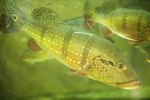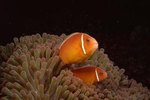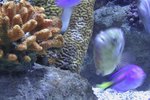Tiny symbiotic algae live in the cells of soft coral. The algae provide energy for the coral, allowing them to survive on little more than sunlight and clean water. The standard guidelines for lighting corals are based on the wattage of the lights, but these guides have limitations.
Wattage for Florescents
In order to keep soft coral alive you will need special, high-output fluorescent lighting like T5 fluorescents. The general guideline is that coral needs at least 5 watts per gallon. However, this varies depending on the species of coral, so research the soft coral you want to keep. This rule also breaks down in deeper aquariums, so err on the side of more lighting for deeper aquariums, or keep your coral in the upper reaches of the aquarium.
Wattage for Metal Halide
Metal halide lighting works differently from fluorescent lighting. Metal halide lights generate more powerful lighting than fluorescent tubes, so they work better in deeper aquariums. They also cost more, use more electricity and kick off more heat. Some metal halides are so hot they need cooling fans so they won't overheat the aquarium. Despite the differences between metal halides and fluorescent tubing, the same 5-watts-per-gallon rule is considered the best guideline for picking a compact fluorescent bulb.
Replacing Bulbs
Regardless of wattage, both metal halides and fluorescent tubes need to be replaced yearly. Even before they burn out, these lightbulbs fade and change spectrum. Often these changes are invisible to the human eye, but life-altering for soft corals. However, corals get used to their lighting, so don't replace all your lights at once. Stagger bulb changes to avoid shocking your soft corals with sudden changes in lighting intensities.
LEDs and PAR
While most aquarium lighting is measured by the bulb's wattage, a new type of aquarium light is changing the game. LED aquarium lights are much more energy-efficient than other types of lighting. They are so energy-efficient that comparing wattage is pointless. Instead, LED banks are rated in terms of photosynthetically active radiation or PAR. You will have to look up the PAR requirements for the specific species of soft coral you want to keep. On the plus side, most LED rigs include charts of their PAR output at different depths, taking away some of the guesswork associated with the old watts-per-gallon rule.
References
- Tropical Fish Hobbyist Magazine: Aquarium Basics: Lighting
- Tropical Fish Hobbyist: Lighting, Photosynthesis, and Marine Invertebrates
- FishChannel.com: Marine Aquarium Lighting [PDF]
- Marineland: Reef LED Aquarium Lighting System
- Advanced Aquarist: How Much Light?! Analyses of Selected Shallow Water Invertebrates' Light Requirements
- FishChannel.com: Time to Upgrade Your Aquarium Lights?
Photo Credits
-
Medioimages/Photodisc/Valueline/Getty Images





